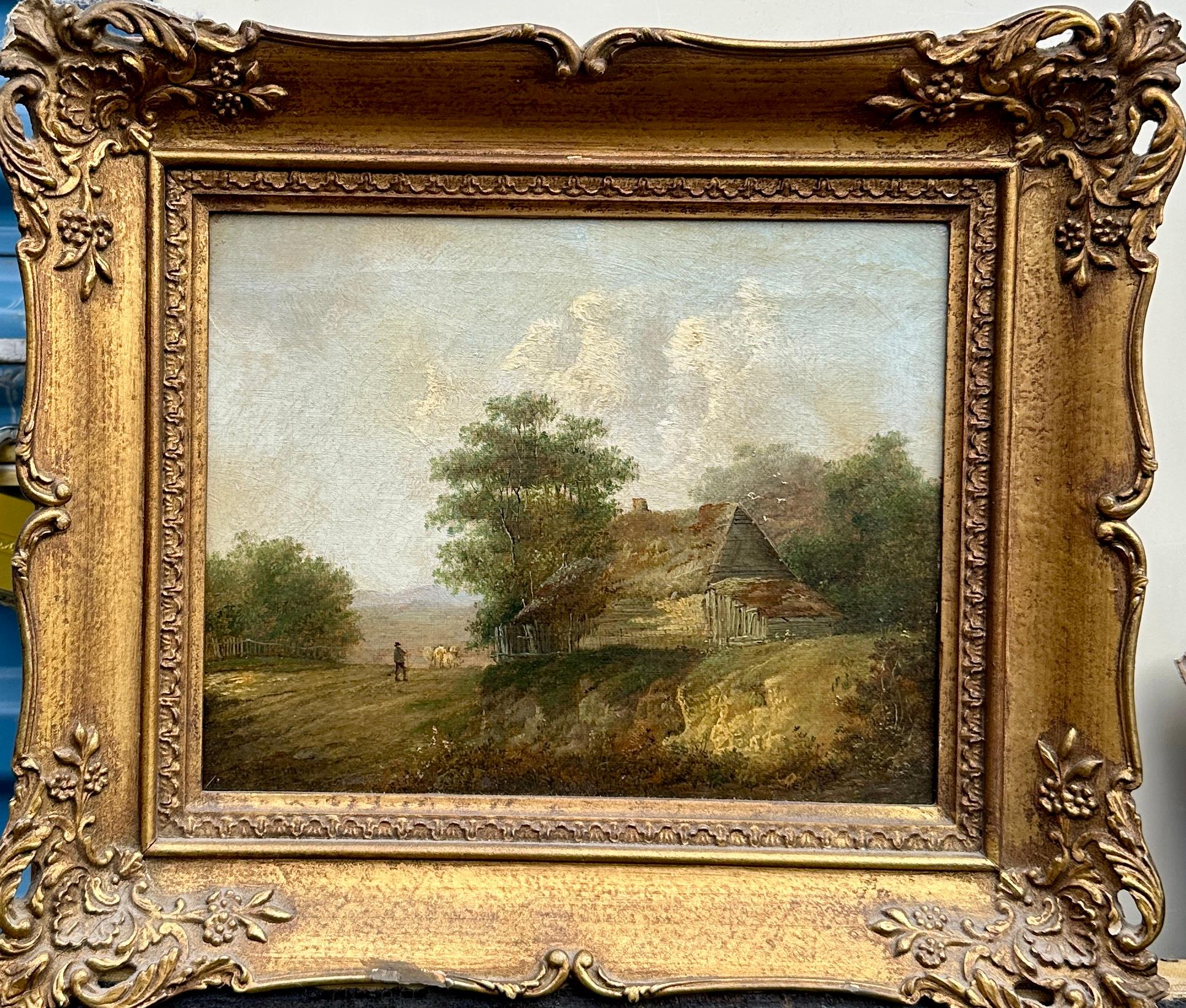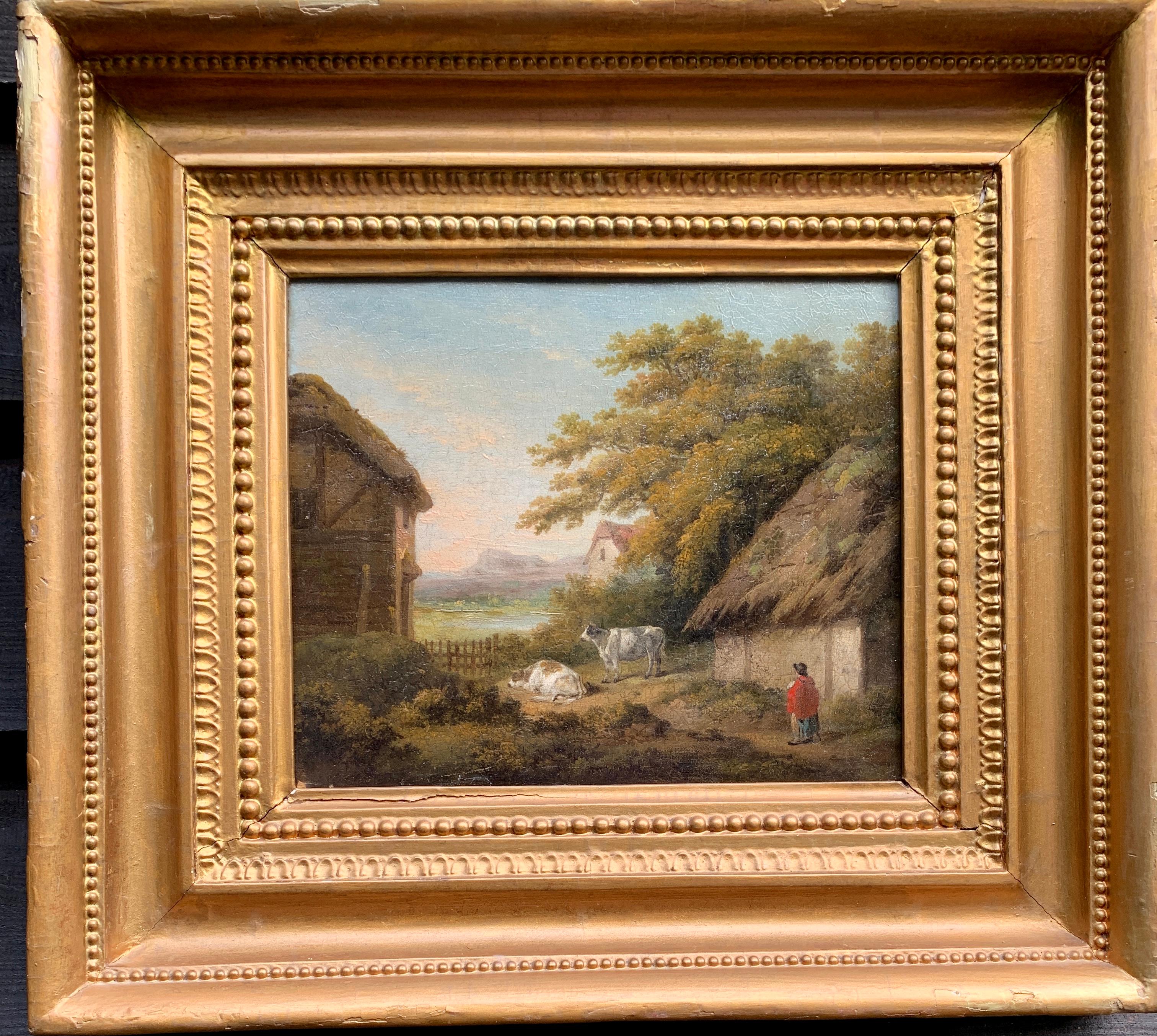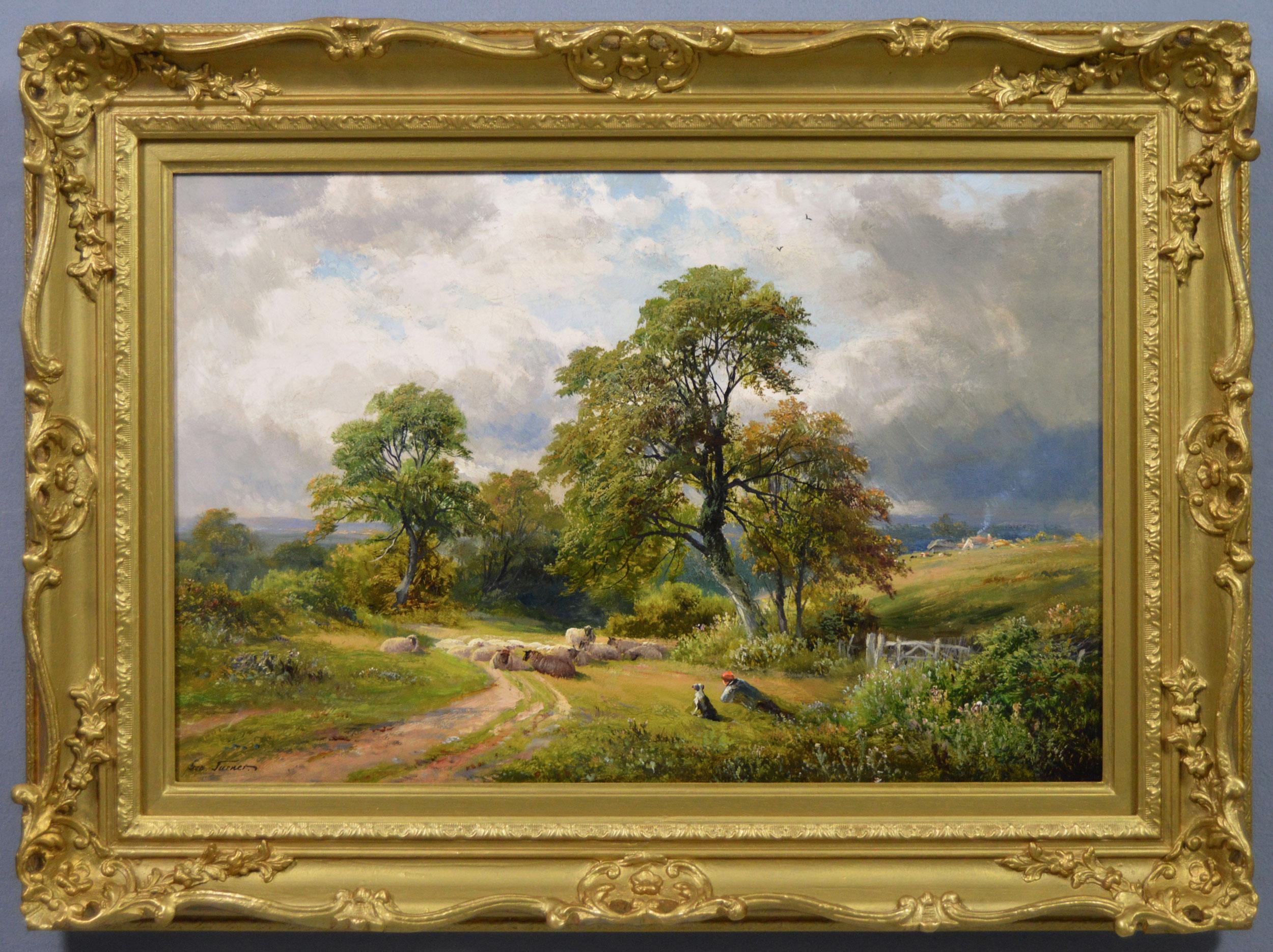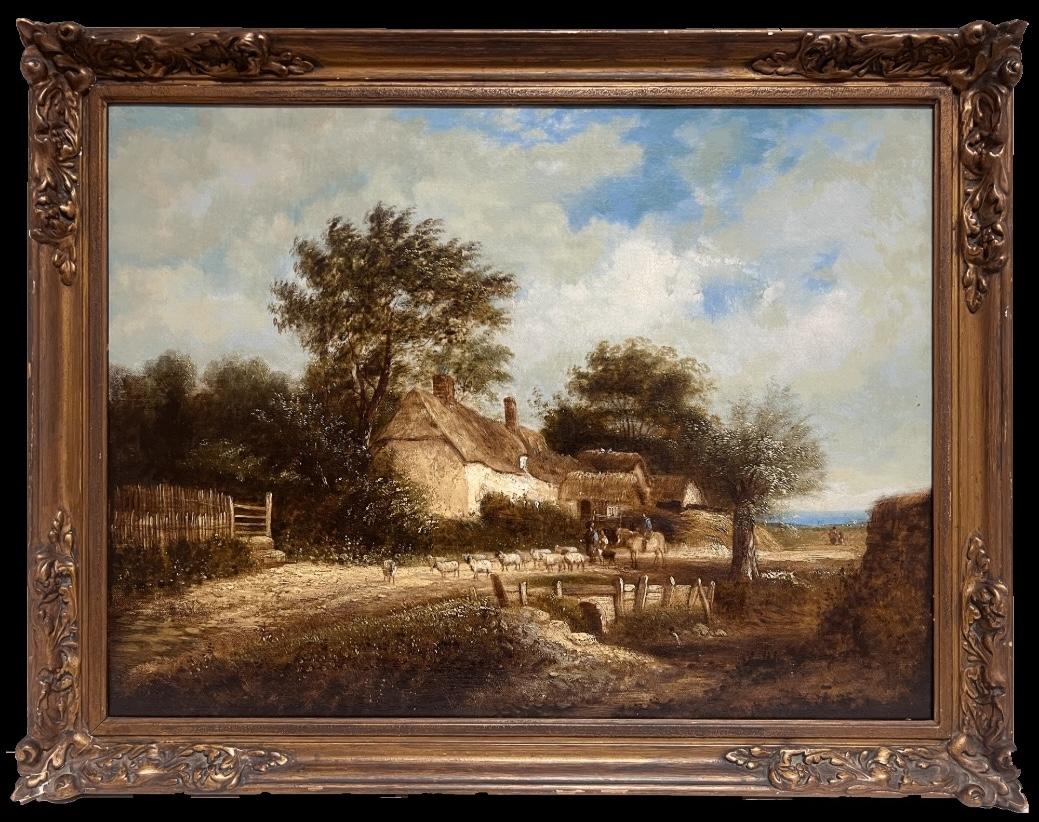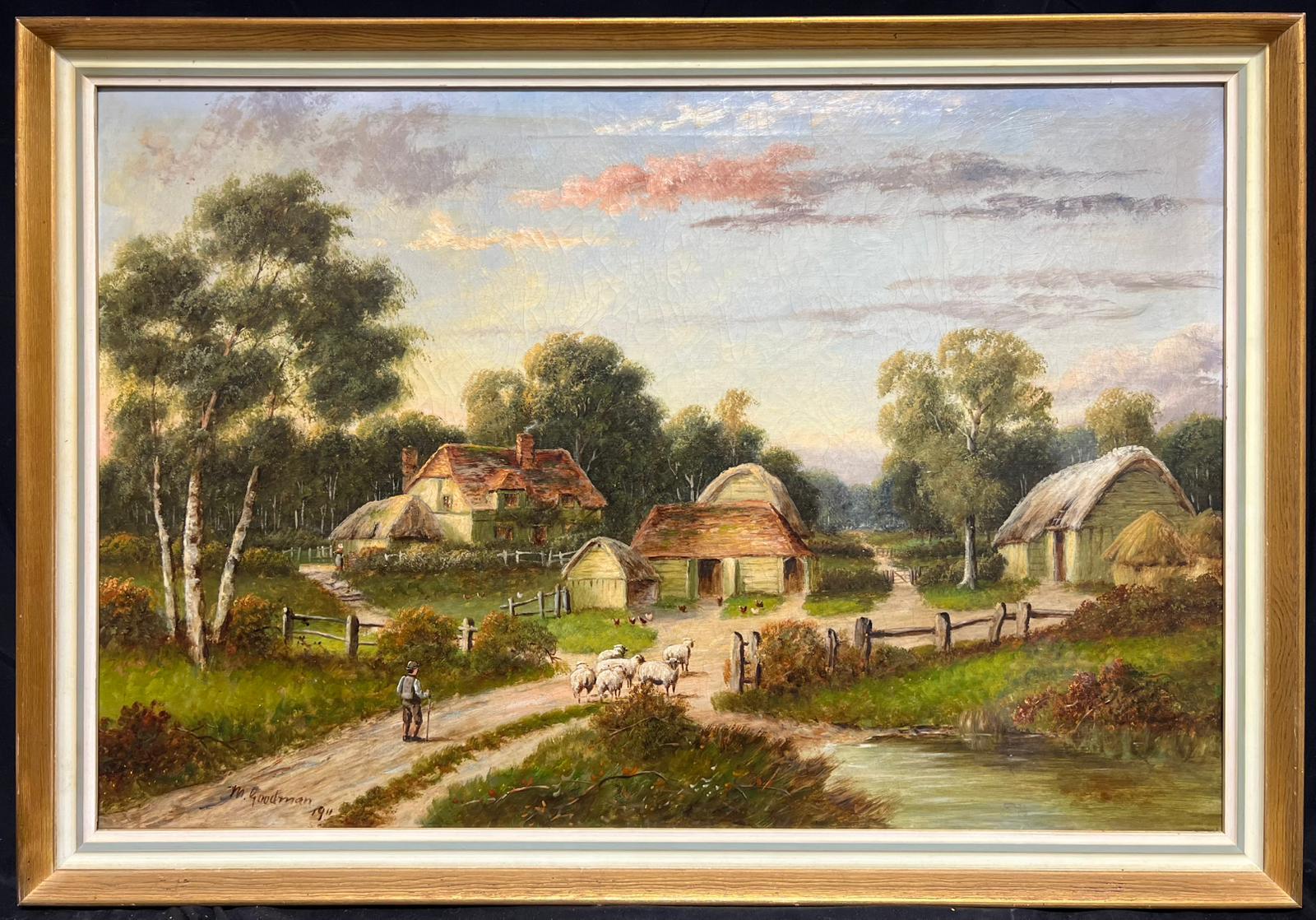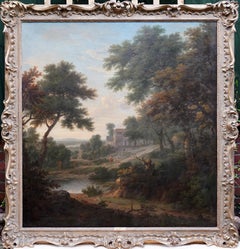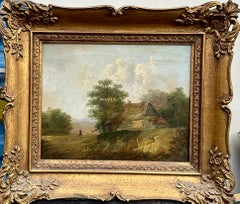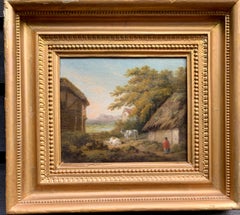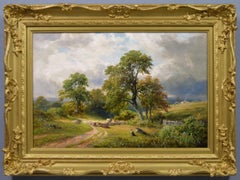Items Similar to Landscape with Cottages and Sheep - British Victorian 1850's art oil painting
Want more images or videos?
Request additional images or videos from the seller
1 of 14
William Henry CromeLandscape with Cottages and Sheep - British Victorian 1850's art oil paintingCirca 1850
Circa 1850
$5,699.89
$7,124.8720% Off
£4,160
£5,20020% Off
€4,852.42
€6,065.5220% Off
CA$7,807.43
CA$9,759.2920% Off
A$8,683.57
A$10,854.4620% Off
CHF 4,534.29
CHF 5,667.8620% Off
MX$105,669.75
MX$132,087.1920% Off
NOK 57,909.78
NOK 72,387.2220% Off
SEK 54,309.15
SEK 67,886.4420% Off
DKK 36,215.44
DKK 45,269.3020% Off
Shipping
Retrieving quote...The 1stDibs Promise:
Authenticity Guarantee,
Money-Back Guarantee,
24-Hour Cancellation
About the Item
This superb oil on panel painting is by British Victorian artist William Henry Crome, son of artist John Crome, founder of the Norwich School. Painted circa 1850 the painting depicts a wooded landscape with a shepherd driving sheep along a lane past cottages. A town can be seen in the background. It is a sunny day and sunlight picks out the shepherd and his sheep as they pause to converse with another figure. The sunlight also lights up the nearby cottage giving it a lovely glow and one can see there is great detail in the trees. A beautiful old painting by a British Old Master.
Unsigned.
Provenance. Christies, South Kensington, 5/6/1997 - Lot 70.
Condition. Oil on panel. Image size 36 inches by 26 inches and in good condition.
Housed in a gallery frame, framed size is 44 inches by 34 inches and in excellent condition.
William Henry Crome was born in Norwich on 22nd October 1806. He was the 3rd son of John Crome, one of the founders of the Norwich school. William Henry was very unfortunate in losing his father at the early age of fifteen. Whilst John Berney, his older brother, had sheltered under his father’s wing, William had to make his own way, and this he commenced to do with good effect. Father John Crome died in 1821. William would have assisted his father in the studio at the age of 15 and was probably becoming quite competent. John Berney probably carried on the tuition and many of William’s early works were moonlights and one can decidedly see the influence of his elder brother. In 1826 William Henry was sufficiently competent to exhibit a painting entitled A View at Costessey, Norfolk, at the British institution. The acceptance of the exhibit must have spurred him on. William Married Mary Ann Steel, it is not known how many children they had but at least one son, Vivian painted. At the Age of 24 William was beginning to look towards one of the Old Masters – Claude Lorraine, for influence. This influence can be identified in many of his Scottish scenes painted around 1830. William travelled to the continent, his visit is recorded by an inscription on a painting, it reads: Near Aix La Chappelle, Brussels 1854. There are other paintings signed and dated 1866. William Henry Crome died in 1873.
- Creator:William Henry Crome (1806 - 1873, British)
- Creation Year:Circa 1850
- Dimensions:Height: 34 in (86.36 cm)Width: 44 in (111.76 cm)Depth: 2 in (5.08 cm)
- Medium:
- Movement & Style:
- Period:
- Condition:
- Gallery Location:London, GB
- Reference Number:1stDibs: LU853113061452
About the Seller
5.0
Platinum Seller
Premium sellers with a 4.7+ rating and 24-hour response times
1stDibs seller since 2018
453 sales on 1stDibs
Typical response time: 1 hour
- ShippingRetrieving quote...Shipping from: London, United Kingdom
- Return Policy
Authenticity Guarantee
In the unlikely event there’s an issue with an item’s authenticity, contact us within 1 year for a full refund. DetailsMoney-Back Guarantee
If your item is not as described, is damaged in transit, or does not arrive, contact us within 7 days for a full refund. Details24-Hour Cancellation
You have a 24-hour grace period in which to reconsider your purchase, with no questions asked.Vetted Professional Sellers
Our world-class sellers must adhere to strict standards for service and quality, maintaining the integrity of our listings.Price-Match Guarantee
If you find that a seller listed the same item for a lower price elsewhere, we’ll match it.Trusted Global Delivery
Our best-in-class carrier network provides specialized shipping options worldwide, including custom delivery.More From This Seller
View AllLandscape with Cattle - Surrey - British Victorian art 19th century oil painting
By George William Mote
Located in London, GB
This charming Victorian landscape oil painting is by noted prolific exhibited British artist George William Mote. Mote was very fond of painting landscapes in Surrey and this is a pa...
Category
1880s Victorian Landscape Paintings
Materials
Oil
Manor House with Cottages - British 18thC Old Master art oil painting VG prov.
By George Lambert
Located in London, GB
This stunning British Old Master landscape oil painting, with excellent provenance, is by George Lambert. Lambert was a pioneer of British landscape in art for its own sake. Painted in 1744, the painting is entitled View of a Manor House and Cottages in Elizabeth Einberg's 63rd volume of the Walpole Society 2001 and is described as follows: In the foreground a road emerges from a wood to cross a ford and then leads up the hill to the right, towards a manor house seemingly built into the remains of a medieval or Tudor edifice. The main track, crowded with sheep and rustic figures, passes the massive square gateposts lower down the hill on the left. Further to the left is a thatched cottage with smoke coming out the chimney. In the distance is a wide coastal view. The main buildings, which are in the dead centre of the composition, represent almost certainly an as yet unidentified English view.
The colouring and detail in the trees and foliage are superb. This is an excellent Old Master oil painting by one of the all time great British landscape artists with extensive provenance.
Signed and dated 1744 lower left on rock in black.
Provenance. Elizabeth Einberg, “Catalogue Raisonnè of the works of George Lambert” The Annual Volume of the Walpole Society, 2001 Vol. 63, page 149 no P1744, fig.71.
Antonacci Efrati Antichità Rome Gallery.
Burden sale, Parke Bernet, New York, 20-21, April 1938 (376 repr.)
Robert E. Peters, Sotheby Parke Bernet, New York, March 1975 (41 repr.)
Lit. Schnackenburg 1995, pp 83-84, cat. no.14 fig 13.
Condition. Oil on canvas, 54 inches by 52 inches and in good condition.
Frame. Housed in an ornate gilt frame, 64 inches by 62 inches and in good condition.
George Lambert (1700-1765) was an English landscape artist and theatre scene painter. With Richard Wilson he is recognised as a pioneer of British landscape in art, for its own sake. Lambert was born in Kent and studied art under Warner Hassells and John Wootton, soon attracting attention by the quality of his landscape painting. He painted many large and fine landscapes in the style of Gaspar Poussin and Salvator Rosa. Many of his landscapes were finely engraved by François Vivares, James Mason (1710–1785), and others, including a set of views of Plymouth and Mount Edgcumbe (painted conjointly with Samuel Scott), a view of Saltwood Castle in Kent, another of Dover, and a landscape presented to the Foundling Hospital in London. Lambert also obtained a great reputation as a scene-painter, working at first for the Lincoln's Inn Fields Theatre, in London, under John Rich. When Rich moved to Covent Garden Theatre, Lambert secured the assistance of Amigoni, and together they produced scenery of far higher quality than any previously executed. Lambert was a man of jovial temperament and shrewd wit, and frequently spent his evenings at work in his painting-loft at Covent Garden Theatre, to which men of note in the fashionable or theatrical world resorted to share his supper of a beef-steak, freshly cooked on the spot. Out of these meetings arose the well-known "Beefsteak Club" which long maintained a high social reputation. Most of Lambert's scene-paintings unfortunately perished when Covent Garden Theatre was destroyed by fire in 1808. Lambert was a friend of William Hogarth and a member of the jovial society that met at 'Old Slaughter's' Tavern in St Martin's Lane. In 1755 he was one of the committee of artists who proposed a royal academy of arts in London. He was a member of the Society of Artists of Great Britain, exhibited with them in 1761 and the three following years, and during the same period contributed to the Academy exhibitions. In 1765 he and other members seceded and formed the Incorporated Society of Artists of Great Britain, of which he was elected the first president. In conjunction with Samuel Scott, Lambert painted a series of Indian views for the old East India House in Leadenhall Street. He also etched two prints after Salvator Rosa. Lambert was associated in 1735 with George Vertue, Hogarth, and John Pine (engraver, 1660–1756) in obtaining a bill from parliament securing artists a copyright on their works. Lambert's portraits were painted by Thomas Hudson, John Vanderbank (engraved in mezzotint by John Faber the younger in 1727, and in line by H. Robinson and others), and Hogarth. Lambert's most famous painting is "A view of Box Hill, Surrey" (1733) which depicts a well-known beauty spot south of London. Hogarth considered Lambert a rival to the famous French landscape painter Claude Lorrain (1600–1682) with respect to his use of soft light to unify the scene in this painting. Though he never visited Italy he was inspired by the classical tradition of landscape painting. Lambert died on 30 November 1765 at his home on the Piazza in Covent Garden. His pupils included John Inigo Richards...
Category
Mid-18th Century Old Masters Landscape Paintings
Materials
Oil
$153,458 Sale Price
20% Off
Cattle and Drover in a Landscape - British Victorian art landscape oil painting
Located in London, GB
This gorgeous oil on canvas Victorian Old Master painting is by British artist Henry Jutsum. Painted circa 1850 the painting depicts a drover on horse back bringing up the rear behin...
Category
19th Century Old Masters Landscape Paintings
Materials
Oil
Sheep in a Surrey Landscape - British Victorian art sunny landscape oil painting
By George William Mote
Located in London, GB
This lovely Surrey landscape oil painting is by noted British exhibited artist George William Mote. Painted circa 1870, the composition is a landscape with a stunning view into the d...
Category
19th Century Realist Landscape Paintings
Materials
Oil
Pastoral Landscape - British 18th century Old Master art oil painting
Located in London, GB
This superb Old Master 18th century figurative landscape oil painting is by noted French born artist Philip James Loutherbourg. who settled in England in 1771. The painting has good ...
Category
1770s Old Masters Landscape Paintings
Materials
Oil
Philip James LoutherbourgPastoral Landscape - British 18th century Old Master art oil painting, 1778
$13,153 Sale Price
20% Off
Cadzow Forest Scotland - British mid 19thC art Scottish landscape oil painting
By Samuel Bough
Located in London, GB
This lovely British Victorian landscape oil painting is by noted artist Sam Bough. It was painted in 1855 after Bough had moved to Hamilton Lanarkshire in Scotland to focus on painting landscapes alongside fellow artist Alexander Frazer. The location is the ancient forest of Cadzow in Lanarkshire which they both favoured. The landscape is of a rough path through ancient oaks heading towards more dense forest with white cattle grazing to the right. A superb balanced composition and an excellent example of Bough's skill in landscape painting.
Signed lower left and dated 1855.
Provenance. Christie's stencil verso 519GG.
James Bourlet & Sons label verso.
Condition. Oil on canvas, 28 inches by 18 inches unframed and in good condition.
Frame. Housed in an ornate gilt Victorian frame, 35 inches by 25 inches framed and in good condition.
Samuel Bough RSA (1822–1878) was an English-born landscape painter who spent much of his career working in Scotland. He was born the third of five children in Abbey Street, Carlisle in northern England, the son of James Bough (1794-1845), a shoemaker, and Lucy Walker, a cook. He was raised in relative poverty, but with a keen encouragement in the arts. He was self-taught but mixed with local artists such as Richard Harrington and George Sheffield, and was strongly influenced by the work of Turner. After an unsuccessful attempt to live as an artist in Carlisle he obtained a job and as a theatre scenery painter in Manchester in 1845, later also working in Glasgow in the same role. Encouraged by Daniel Macnee to take up landscape painting he moved to Hamilton from 1851-4 and worked there with Alexander Fraser. In 1854 he moved to Port Glasgow to work on his technique of painting ships and harbours. His paintings were noted for their sensitivity to atmosphere and light, were often of cloudy shorelines and busy harbours. He also began supplementing his income by illustrating books, before moving to Edinburgh in 1855. On coming to Edinburgh he lived in a terraced house at 5 Malta Terrace in the Stockbridge area of the city. Following Turner's example, he became a skil ful painter of seaports. He was buried in Dean Cemetery Edinburgh on 23 November 1878. The grave bears a bronze medallion of his head by William Brodie...
Category
Mid-19th Century Realist Landscape Paintings
Materials
Oil
$8,714 Sale Price
20% Off
You May Also Like
19th century English landscape with Cottage
By Charles Morris
Located in Woodbury, CT
Charles Morris (British, active mid-19th century)
Rustic Landscape with Herdsman and Cottage, ca. 1860–1870
Oil on canvas
In this tranquil rural view, Charles Morris presents an idy...
Category
1870s Victorian Landscape Paintings
Materials
Canvas, Oil
19th century Victorian English Antique landscape with cottage, figure and cows
By George Morland
Located in Woodbury, CT
Wonderful and outstanding example by one of England's known and much-loved 18th and 19th-century painters. Morland was an English painter who became one of the most popular artists o...
Category
Early 1800s Victorian Figurative Paintings
Materials
Oil, Canvas
$3,600 Sale Price
20% Off
Free Shipping
19th Century landscape oil painting of a shepherd & flock in a country lane
By George Turner
Located in Nr Broadway, Worcestershire
George Turner
British, (1843-1910)
Near Tonge, Leicestershire
Oil on canvas, signed
Image size: 15.25 inches x 23.25 inches
Size including frame: 22.75 inches x 30.75 inches
A cha...
Category
19th Century Victorian Landscape Paintings
Materials
Canvas, Oil
Fine Victorian English Oil Rural Cottage Landscape Figures & Animals in Lane
Located in Cirencester, Gloucestershire
The Rural Lane
English School, mid Victorian period, circa 1860'1870
oil on canvas, framed
framed: 21.5 x 27 inches
canvas: 18 x 24 inches
Provenance: private collection, England
Con...
Category
Mid-19th Century English School Landscape Paintings
Materials
Canvas, Oil
Antique English Countryside Oil Painting Shepherd with Sheep and Rural Farmstead
Located in Cirencester, Gloucestershire
Returning to the Fold
English artist, 'M. Goodman'
signed & dated 1911
oil on canvas, framed
framed: 22.5 x 32.5 inches
canvas: 20 x 30 inches
Provenance: private collection, England...
Category
Early 20th Century Victorian Landscape Paintings
Materials
Oil
Large Victorian Norwich School Oil Thatched Cottages in Rural Landscape, framed
Located in Cirencester, Gloucestershire
Artist/ School: Norwich School, circa 1876
Title: 'Norfolk Clay Lump and Thatched Cottages'.
Medium: oil on canvas, framed
Framed: 24 x 31 inches
Painting: 19 x 26 inches
Provenance: private collection, East Anglia...
Category
19th Century Victorian Landscape Paintings
Materials
Oil, Canvas
More Ways To Browse
Oil Painting Of Sheep
Landscape Painting With Sheep
Antique Sheep Painting
19th Century Landscape Unsigned
19th Century Landscape Painting Unsigned
Victorian Painting Children
Sheep And Landscape Framed Oil Paintings
Antique Sheeps Paintings Landscaping
19th Century Painting Sheep
John Lane
Norwich School
Norwich School Paintings
Antique Spurs
Moonlight Scene
Shepherd And Sheep
1850s Oil Paintings
British Sheep Painting
S Shepherd
